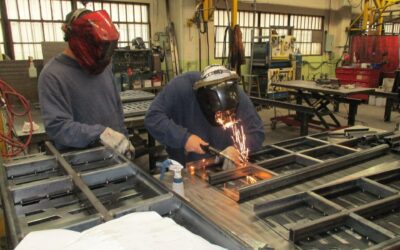There has been a lot of talk recently about creating and maintaining a ‘learning culture’ in manufacturing. You may have asked yourself, ‘how do we know if we’re a learning organization’ and then scratched your head, wondering what a ‘learning organization’ actually looks like…
What is a learning organization?
The concept of a learning organization is not new. This phrase was coined by Peter Senge, in the book The Fifth Discipline, first published in 1990. In his book, Peter Senge proposed the following five disciplines of a learning organization: personal mastery, mental models, building shared vision, team learning, and systems thinking.
The Fifth Discipline defines personal mastery as “a discipline of continually clarifying and deepening our personal vision, of focusing our energies, of developing patience, and of seeing reality objectively.”
Mental models are “deeply ingrained assumptions, generalizations, or even pictures of images that influence how we understand the world and how we take action.” Building a shared vision means “unearthing shared pictures of the future” and team learning is “the capacity of members of a team to suspend assumptions and enter into genuine thinking together.” The last discipline, systems thinking, integrates the prior four disciplines and looks at an organization as the sum of the collective interactions between its employees.
How do you know whether your company is a learning organization?
A culture of learning is often a feeling rather than a set of strict disciplines. You can sense it when you walk through the door. So what do you do if you need more than a feeling? You can look for these signs:
All employees understand and believe in the company’s vision, mission, and values.
Does your company have a vision, mission, and values statement? Is it updated every year or gathering dust? Is it in language that is clear and understandable by every employee or does it seem like a bunch of words strung together with no real meaning? Who updates it and how is it communicated to the rest of your employees? Is it a placard on the wall or can your employees recite it without looking?
Continuous improvement is a constant state of mind in every person, from the front line to CEO.
Having a culture of learning means that everyone is always striving to improve, both personally and company-wide. No one is perfect and perfection can never be achieved, but everyone at your organization should be striving to make small improvements every day (‘one degree shifts’). Improvement should be a daily habit and not taken TOO seriously. Everyone makes mistakes, and everyone can benefit from improving. Without mistakes, there is no learning.
Learning is an integral part of your company’s culture.
Does your company invest in developing its employees’ skills and knowledge? Do you set aside time to learn from each other even if it takes time away from achieving the bottom line? Does your company encourage their employees to pursue career enhancing learning both inside and outside the organization?
Respect is the norm.
You know whether your company has a culture of respect by the way you are treated, treat others, and by the behaviors you observe on a daily basis. How do different departments talk to – and talk about – each other? Is there equal respect for everyone’s unique roles in the company, whether they are the CEO or a front line worker?
Open communication is the norm.
Are you having to read between the lines and become a part-time detective to know what the heck is going on in your company? Are there open lines of communication in a myriad of ways throughout the company (e.g. ‘all hands’ meetings, visual scoreboards, key performance indicators, etc.)? Do workplace politics get in the way of having frank, objective, and constructive conversations? Open communication is quite possibly the most important sign of a learning organization.
Employees are aligned with company goals, objectives, and strategies.
Everyone in your organization should have a clear idea what your company’s short term and long term goals, objectives, and strategies are – not just your leadership team. This provides the ‘bigger picture’ for why they come to work every day, and ensures that decisions are made that align with the best interests of the organization. This alignment ultimately benefits employees on every level. If the company grows, you grow too!
Don’t worry if your company culture is a far cry from being perfect on all six counts. No company is. The point is to keep working on building a learning culture, one day at a time, until you can’t help but get that feeling when you walk in the door.
Can OMEP Help You Become an Employer of Choice? We’re Here to Help >
References:
1990, The Fifth Discipline: The art and practice of the learning organization, Doubleday, New York.



